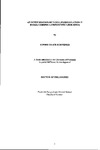An investigation of T cell dysregulation in B-cell chronic lymphocytic leukaemia
| dc.contributor.author | SCRIVENER, SOPHIE GRACE | |
| dc.contributor.other | Faculty of Health | en_US |
| dc.date.accessioned | 2013-11-18T13:11:32Z | |
| dc.date.available | 2013-11-18T13:11:32Z | |
| dc.date.issued | 2003 | |
| dc.date.issued | 2002 | |
| dc.identifier | NOT AVAILABLE | en_US |
| dc.identifier.uri | http://hdl.handle.net/10026.1/2735 | |
| dc.description | Merged with duplicate record 10026.1/579 on 14.03.2017 by CS (TIS) | |
| dc.description.abstract |
B-cell chronic lymphocytic leukaemia (B-CLL) is characterized by an accumulation of clonal malignant B cells within lymphoid tissue, the bone marrow and the peripheral blood. Whilst abnormalities of these B cells are the essential cause of this disease, the aim of this research project was to investigate whether the T cell compartment may play a role in the aetiology of this disease by evaluating the expression of key surface antigens involved in both activation of and interaction with B cells and other antigen presenting cells of the immune system. There were marked abnormalities in the expression of certain key activation and interaction antigens on the peripheral blood T cells of patients with B-CLL, in particular, compared to normal controls, there was a significant reduction in the number of circulating T cells expressing CD25, CD28, CD152, CD4, CD5 and CD11a. There was no difference in expression of TCRαβ, CD8, CD54 and CD154. Significantly more T cells from CLL patients expressed HLA-DR. Removal of the malignant clone of cells prior to short-term T cell culture did not affect expression of these markers. Numbers of T cells expressing intracellular CD25 and CD152 were not decreased after activation and a significantly greater number of resting T cells expressed both antigens intracellularly. There was also evidence of a soluble factor present in CLL AB serum which caused increased numbers of normal and CLL T cells to express CD25 and CD152 after culture. Initial results suggest that this may be IFN-γ, levels of which were significantly higher, as measured by ELISA, from resting CLL T cells compared to normals. By studying the expression of these antigens using cell culture, flow cytometric and ELISA techniques, the results suggest a functional state of anergy in these T cells. This anergic state may contribute to the pathogenesis of B-CLL and its related phenomena of immunosuppression and autoimmunity. This was further reflected in the results of the T cell functional studies and reduced IL-2 expression in the mixed lymphocyte reaction (MLR). | en_US |
| dc.language.iso | en | en_US |
| dc.publisher | University of Plymouth | en_US |
| dc.title | An investigation of T cell dysregulation in B-cell chronic lymphocytic leukaemia | en_US |
| dc.type | Thesis | |
| plymouth.version | Full version | en_US |
| dc.identifier.doi | http://dx.doi.org/10.24382/3585 |
Files in this item
This item appears in the following Collection(s)
-
01 Research Theses Main Collection
Research Theses Main


